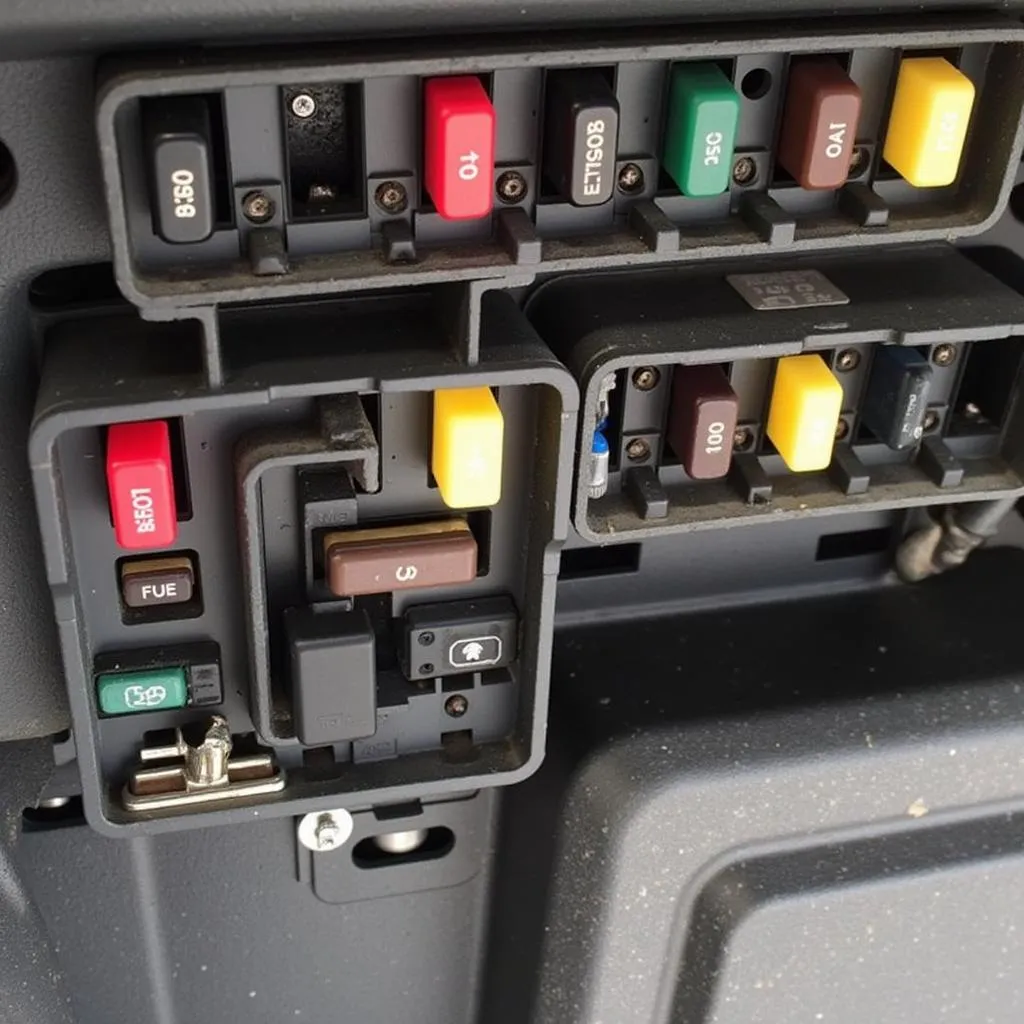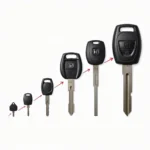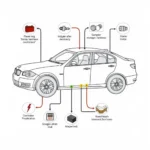Car lights are essential safety components of your vehicle, ensuring visibility during low-light conditions and signaling your intentions to other drivers. A malfunctioning car light can significantly compromise safety and even lead to legal issues. While some car light repairs might require professional assistance, many can be diagnosed and fixed at home with basic tools and a bit of know-how. This guide will illuminate the common causes of car light failures and provide you with a step-by-step approach to repair them.
Understanding the Types of Car Lights and Their Common Issues
Before diving into repairs, it’s crucial to identify the type of car light that’s malfunctioning. Each type serves a specific purpose and may have unique failure points.
Headlights
Headlights are crucial for illuminating the road ahead, especially during nighttime driving.
Common Issues:
- Burned-out bulb: The most frequent culprit, often indicated by a dim or completely extinguished headlight.
- Faulty wiring or connections: Corrosion, loose connections, or damaged wires can disrupt the flow of electricity to the headlight.
- Malfunctioning headlight relay: This electrical switch controls the power supply to the headlights and can fail, causing both headlights to stop working.
Tail lights
Tail lights signal your presence and position to vehicles behind you, especially important during braking.
Common Issues:
- Burned-out bulb: Similar to headlights, a burned-out bulb is a common cause of tail light failure.
- Damaged socket: The socket holding the bulb can become corroded or damaged, preventing proper electrical contact.
- Blown fuse: A blown fuse in the car’s electrical system can interrupt power to the tail lights.
Turn Signals
Turn signals are crucial for communicating your intention to turn or change lanes, ensuring predictable maneuvers.
Common Issues:
- Burned-out bulb: A burned-out turn signal bulb will result in a faster flashing rate or no flashing at all.
- Faulty turn signal relay: The turn signal relay is responsible for the blinking action, and a faulty one can cause various issues, including hyper-flashing or no flashing.
- Damaged or corroded wiring: Similar to other car lights, damaged or corroded wiring can interrupt the signal, leading to malfunction.
Brake Lights
Brake lights are critical safety components that alert drivers behind you when you are slowing down or stopping.
Common Issues:
- Burned-out bulb: The most common cause of brake light failure is a burned-out bulb.
- Faulty brake light switch: This switch, located near the brake pedal, activates the brake lights when the pedal is pressed. A malfunctioning switch can prevent the lights from illuminating.
- Blown fuse: A blown fuse in the car’s electrical system dedicated to the brake lights can cause a complete outage.
Step-by-Step Guide to Repairing Car Lights
Before attempting any repairs, always refer to your car’s owner’s manual for specific instructions and safety precautions.
1. Identify the Problem:
- Begin by determining which lights are not functioning correctly.
- Is it one side only, both sides, or a specific function like the brake light?
2. Check the Bulbs:
- Once you’ve identified the faulty light(s), start by inspecting the bulb.
- Remove the bulb by twisting or unclipping it, depending on the car model.
- Look for signs of damage like a broken filament or a darkened glass bulb.
- If the bulb appears burned out, replace it with a new one of the same type and wattage.
3. Inspect the Fuses:
- If replacing the bulb doesn’t resolve the issue, the next step is to check the fuses.
- Locate your car’s fuse box, usually under the dashboard or in the engine bay.
- Consult your owner’s manual to identify the specific fuse related to the malfunctioning lights.
- Visually inspect the fuse for any signs of a break or burn.
- If you suspect a blown fuse, carefully remove it with a fuse puller (often found inside the fuse box cover) and replace it with a new one of the same amperage.
4. Examine the Wiring and Connections:
- If the bulbs and fuses are in working order, the problem might lie in the wiring or connections.
- Carefully inspect the wires leading to the light for any signs of damage, such as cuts, fraying, or melting.
- Check the connectors for corrosion, looseness, or damage.
- If you find any issues, repair or replace the affected wires or connectors as needed.
5. Test the Relays and Switches:
- If the problem persists, the relays or switches associated with the lights might be faulty.
- These components can be more challenging to diagnose and repair without specialized knowledge.
- Consider consulting a professional mechanic if you suspect issues with relays or switches.
When to Seek Professional Help
While simple car light repairs can be done at home, some situations warrant professional assistance:
- Complex Electrical Issues: If you suspect problems with relays, switches, or complex wiring, it’s best to seek professional help to avoid further damage or safety hazards.
- Lack of Experience: If you’re uncomfortable working with electrical components or unsure about a diagnosis, it’s safer to consult a mechanic.
- Specialized Tools: Some repairs might require specialized tools or equipment that you may not have access to.
Tips for Maintaining Your Car Lights
Regular maintenance can prevent future car light problems:
- Regularly Inspect Your Lights: Make it a habit to check all your car lights, including headlights, tail lights, brake lights, and turn signals, at least once a month.
- Keep Your Lights Clean: Dirt, grime, and road debris can accumulate on your lights, reducing their effectiveness. Regularly clean your lights with soap and water or a dedicated car light cleaner.
- Address Issues Promptly: If you notice a dim light, a flickering light, or a light that’s out, address the issue as soon as possible.
- Use Quality Replacement Parts: When replacing bulbs, fuses, or other components, use high-quality parts from reputable brands.
FAQs
Q: Why is my turn signal blinking faster than usual?
A: A faster-than-usual blinking turn signal often indicates a burned-out bulb on that side of the vehicle. Replace the bulb, and the blinking rate should return to normal.
Q: Can I replace a headlight bulb myself?
A: Yes, replacing a headlight bulb is a relatively straightforward repair that many car owners can do themselves. Consult your owner’s manual for specific instructions for your car model.
Q: My brake lights are not working, but my tail lights are. What could be the problem?
A: This scenario often points to a faulty brake light switch. This switch, usually located near the brake pedal, activates the brake lights when the pedal is pressed.
Q: How often should I replace my car’s headlights?
A: There’s no set timeframe for headlight replacement. It depends on factors like bulb type, driving habits, and environmental conditions. However, it’s a good idea to inspect them regularly and replace them as soon as they start to dim or show signs of wear.
Q: Can I use any type of fuse to replace a blown fuse in my car?
A: No, using the correct amperage for the fuse is crucial. Using a fuse with a higher amperage than specified can lead to electrical damage and even pose a fire hazard.
Q: What does it mean if my headlights are dim?
A: Dim headlights can have several causes, including a dying battery, a failing alternator, heavily oxidized headlight lenses, or even a headlight bulb nearing the end of its lifespan.
Q: What should I do if I replace a fuse, and it blows again immediately?
A: If a fuse blows immediately after replacement, it usually indicates a short circuit or an overload in the electrical system. It’s essential to consult a qualified mechanic to diagnose and repair the underlying electrical issue.
Need More Help?
Car light repair can seem daunting, but it’s often simpler than it appears. With this guide, you’re well-equipped to tackle common car light problems. However, if you encounter complex issues or feel unsure about a diagnosis, don’t hesitate to seek professional help. Remember, maintaining your car’s lights ensures your safety and the safety of others on the road.
For any assistance or inquiries about car light repair or any other automotive issue, feel free to contact our expert team via WhatsApp at +1(641)206-8880 or email us at [email protected]. We’re available 24/7 to assist you. You can also find helpful information on repairing your car’s cigarette lighter socket or understanding if it’s possible to repair your car cigarette lighter on our website. We’re here to keep your car in top shape!



